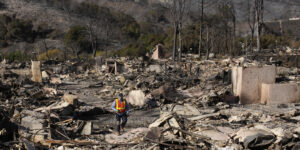The economic losses from the latest round of California storms will be significant, and many of these losses may not be insured because only 2 percent of California residents have purchased flood insurance, David Blades, associate director, industry research and analytics, AM Best, wrote in a report out this week.
“Soaking rains from two different atmospheric rivers have led to repeated flooding events,” which will “shine a spotlight on private flood insurance in California,” Blades wrote.
California is still the second-largest state in private flood premium despite the low take-up of private flood insurance. The state trails only Florida. Private flood insurance accounts for nearly 50 percent of California’s entire flood market, according to the AM Best report.
California accounts for 4 percent of policies from the National Flood Insurance Program, and since NFIP insurance is limited to $250,000 per residence, many of the homes in California protected by NFIP insurance are likely underinsured, the report states.
CoreLogic earlier this week issued estimates that across the greater Los Angeles area, nearly 543,000 single- and multifamily homes with a combined reconstruction cost value (RCV) of more than $258 billion are at risk of flash flood damage.
AccuWeather estimates released on Monday show preliminary total damage and economic loss from the most recent intense storms and record rainfall in California will be between $9 billion and $11 billion.
The severity of recent severe wildfires and mudslides in California are among the growing list of examples of how climate-related risks are changing the risk assessment landscape for property insurers.
“Underwriting and pricing property risks based on prior experience is proving to be unwise because catastrophe models, despite recent updates, do not yet fully take into account the full, evolving scope of property catastrophe risks reflected by these newest storms, and what is becoming the new normal,” Blades wrote.
Several property insurers announced their intention to pull back from or exit California’s market in 2023 as the changing weather patterns are posing growing risks to their profitability.
State Farm General Insurance Co. announced at the end of May that it had stopped accepting new policy applications for property/casualty insurance in California for reasons including increased risks from wildfires and inflation. The decision followed a similar move by Allstate Corp. last year.
Other large carriers that have announced a reduced appetite for writing California homeowners insurance include American International Group (AIG) and Chubb.
A new report from Gallagher Re released late last year showed the threat of damaging wildfires in conjunction with inflation and pricing challenges has led to a distressed insurance and reinsurance market, particularly in California.
The Hartford confirmed in late January it will discontinue writing new homeowners policies in California. The carrier reportedly has less than 1 percent of the state’s homeowners market.
This article was originally published by Insurance Journal.





















 Executives on the Move at Everest Group, Zurich NA, Arch Capital, Plymouth Rock and Intact Financial Corp.
Executives on the Move at Everest Group, Zurich NA, Arch Capital, Plymouth Rock and Intact Financial Corp.  Many Reasons Behind Certain Homes Left Standing After Wildfires
Many Reasons Behind Certain Homes Left Standing After Wildfires  Mercury General Gives Reinsurance Update: One or Two Events Still TBD
Mercury General Gives Reinsurance Update: One or Two Events Still TBD  Damaging Megadroughts Are Spreading Around the World
Damaging Megadroughts Are Spreading Around the World 



